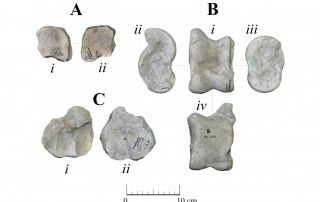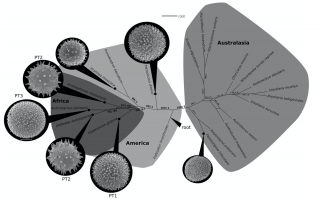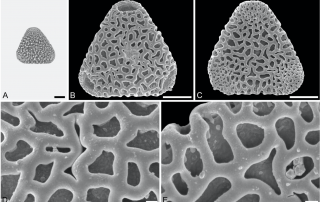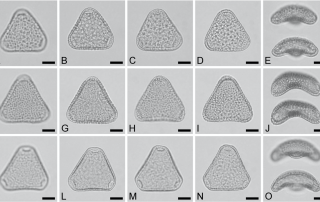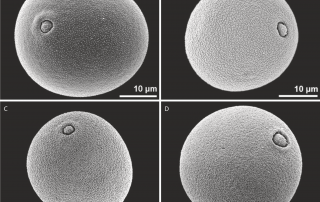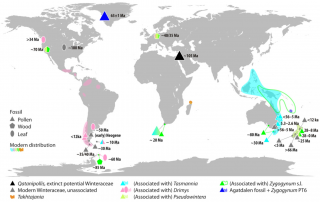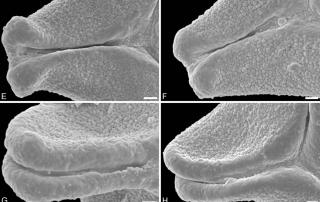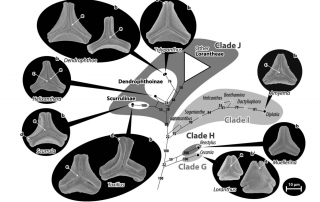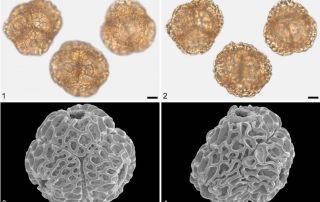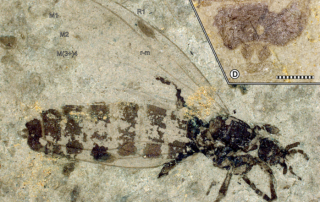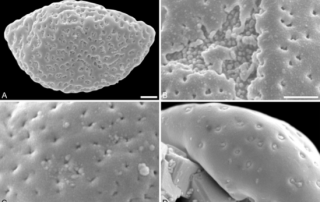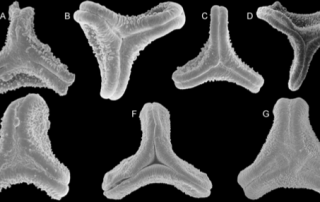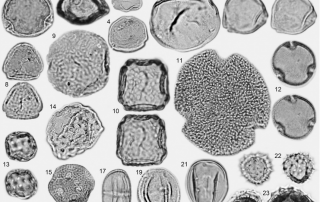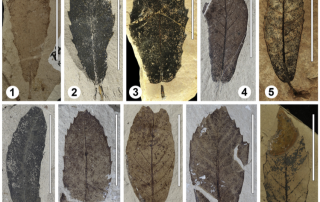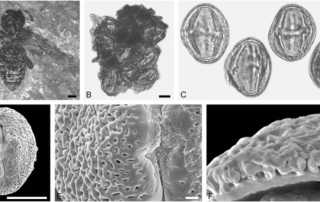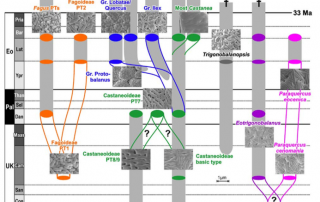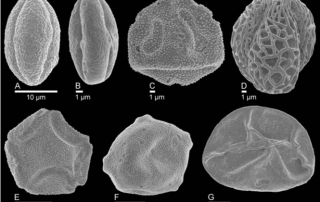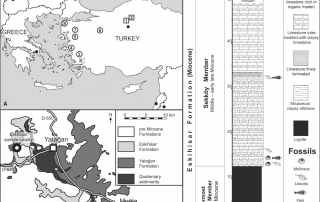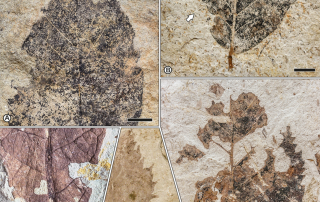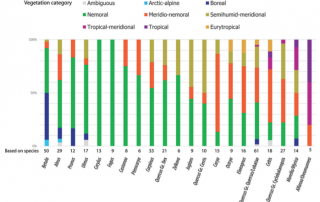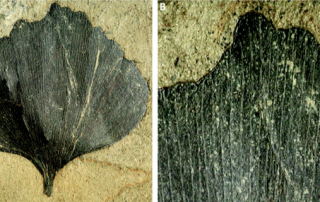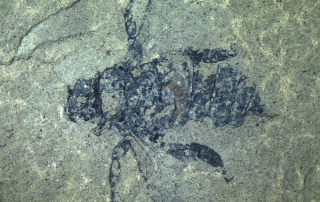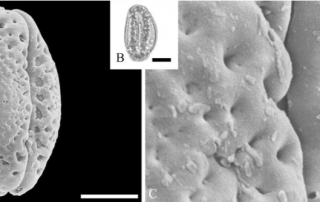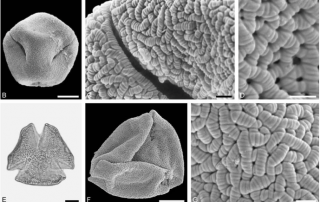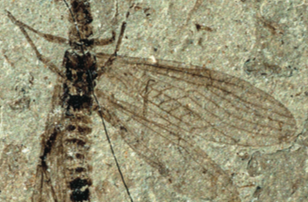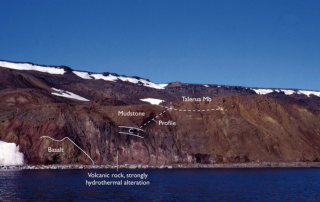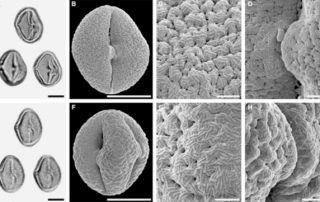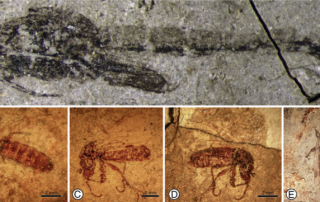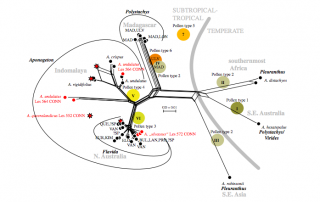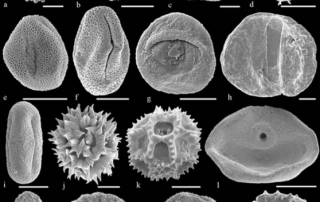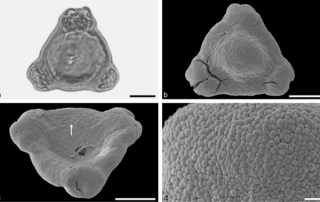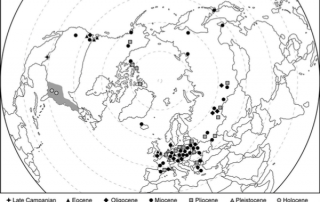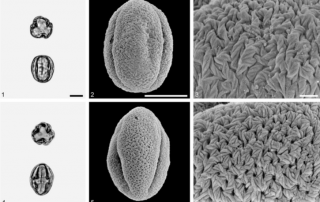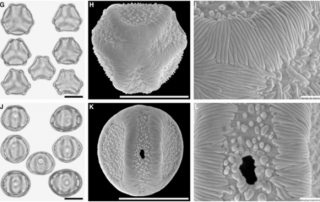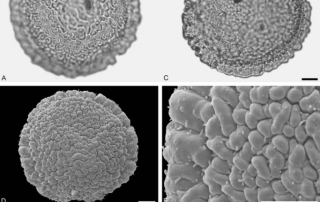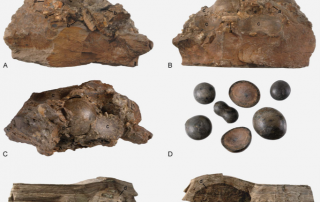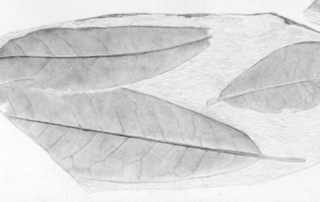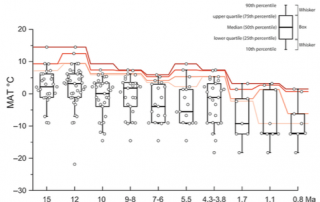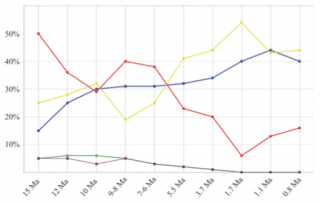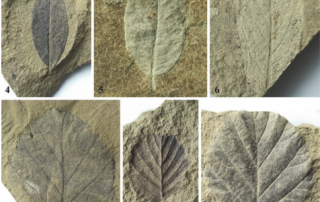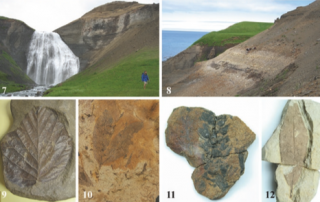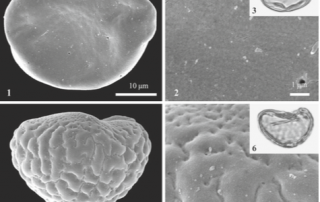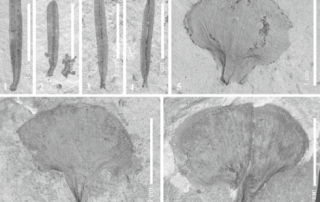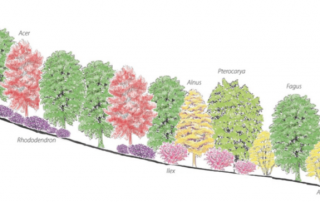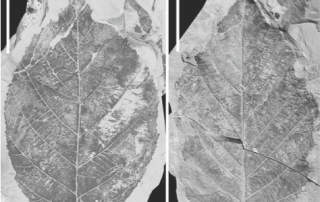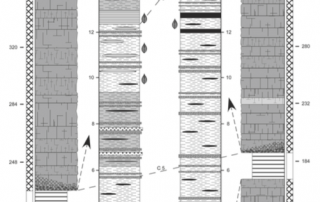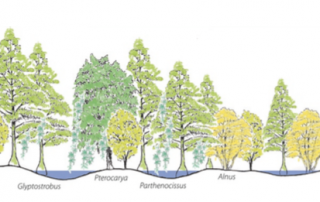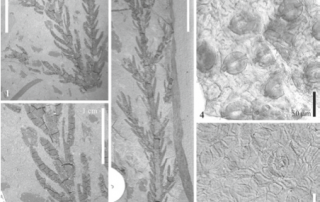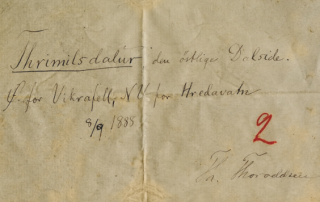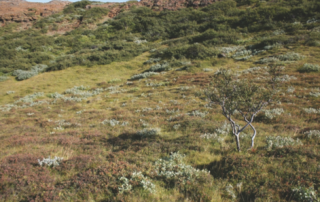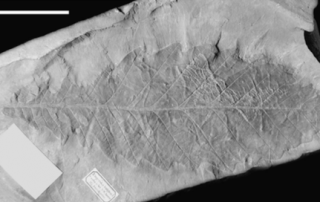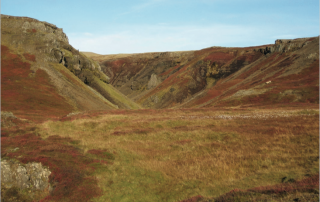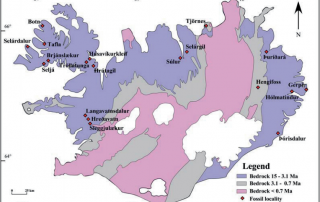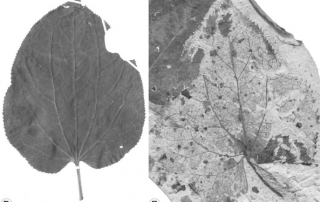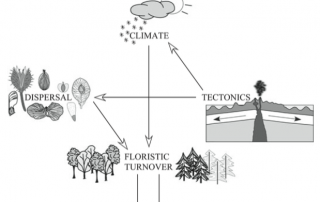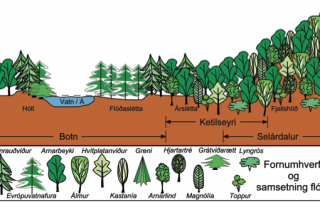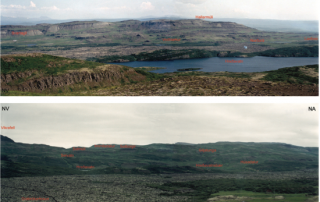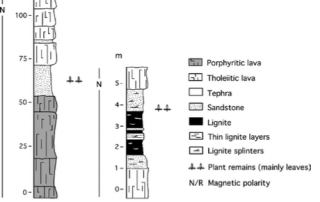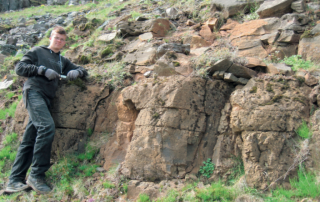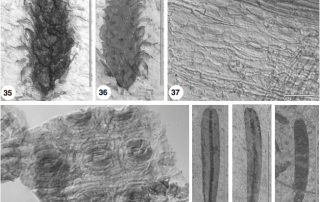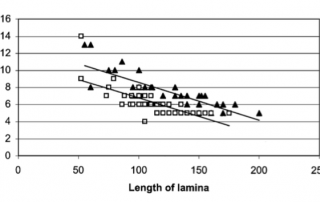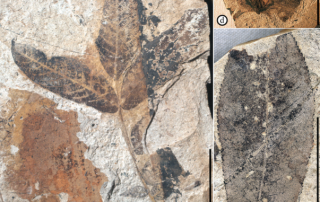Fossil Giraffidae (Mammalia, Artiodactyla) from the early Turolian of Kavakdere (Central Anatolia, Turkey) – 2019
Authors: Alexandros Xafis, Serdar Mayda, Friðgeir Grímsson, Doris Nagel, Tanju Kaya, Kazım Halaçlar
The fossiliferous site at Kavakdere is one of many important late Miocene fossil mammal-bearing localities in Anatolia. Previous taxonomic studies on its fauna have revealed a plethora of taxa. However, the fossil Giraffidae from this early Turolian locality were until now poorly documented. New comprehensive descriptions, comparisons and metric analyses using all accessible Giraffidae specimens from Kavakdere suggest the co-occurrence of five different giraffid taxa. These include
Origin and divergence of Afro-Indian Picrodendraceae: linking pollen morphology, dispersal modes, fossil records, molecular dating and paleogeography – 2019
Authors: Friðgeir Grímsson, Shirley A. Graham, Mario Coiro, Bonnie F. Jacobs, Alexandros Xafis, Frank H. Neumann, Louis Scott, Jakub Sakala, Ellen D. Currano, Reinhard Zetter
The pantropical Picrodendraceae produce mostly spheroidal to slightly oblate, echinate pollen grains equipped with narrow circular to elliptic pori that can be hard to identify to family level in both extant and fossil material using light microscopy only. Fossil pollen of the family have been described from the Paleogene of America, Antarctica, Australia, New Zealand, and Europe, but […]
Sclerosperma fossils from the late Oligocene of Chilga, north-western Ethiopia – 2019
Authors: Friðgeir Grímsson, Bonnie F. Jacobs, Johan L. C. H. van Valkenburg, Jan J. Wieringa, Alexandros Xafis, Neil Tabor, Aaron D. Pan, Reinhard Zetter
The palm family, Arecaceae, is notoriously depauperate in Africa today, and its evolutionary, paleobiogeographic, and extinction history there are not well documented by fossils. In this article we report the pollen of two new extinct species of the small genus, Sclerosperma (Arecoideae), from a late Oligocene (27–28 Ma) stratum exposed along the Guang […]
Pollen morphology of the African Sclerosperma (Arecaceae) – 2019
Authors: Friðgeir Grímsson, Johan L. C. H. van Valkenburg, Jan J. Wieringa, Alexandros Xafis, Bonnie F. Jacobs, Reinhard Zetter
Three currently accepted Sclerosperma species appear to produce four different pollen morphologies. Sclerosperma mannii and S. walkeri pollen share the same distinct reticulate sculpture, but S. profizianum produces three different pollen types (microreticulate, fossulate, and perforate). The pollen morphology suggests that S. mannii
Illustrated Pollen Terminology – 2018
Authors: Heidemarie Halbritter, Silvia Ulrich, Friðgeir Grímsson, Martina Weber, Reinhard Zetter, Michael Hesse, Ralf Buchner, Matthias Svojtka, Andrea Frosch-Radivo
This book provides a fully illustrated compendium of key terms and basic principles in the field of palynology, making it an indispensable tool for all palynologists. It is a revised and extended edition of “Pollen Terminology. An Illustrated Handbook,” released in 2009. This second edition offers additional insights into new and stunning aspects of palynology. Accordingly, the general chapters have been critically revised, expanded andrestructured. The […]
A Winteraceae pollen tetrad from the early Paleocene of western Greenland, and the fossil record of Winteraceae in Laurasia and Gondwana – 2018
Authors: Friðgeir Grímsson, Guido W. Grimm, Alastair J. Potts, Reinhard Zetter, Susanne S. Renner
Winteraceae comprise c. 130 species in seven genera, with the greatest species diversity in the Pacific (Pseudowintera, Zygogynum), Australia (Bubbia, Tasmannia), New Guinea (Belliolum, Bubbia, Zygogynum, Tasmannia) and Madagascar (Takhtajania). Only Drimysoccurs in South America. Because of their Cretaceous leaves, wood and pollen fossils, and their lack of xylem vessels, Winteraceae throw light on early angiosperm evolution. We describe a Winteraceae pollen tetrad from the Paleocene of Greenland, review the family’s […]
The first Loranthaceae fossils from Africa – 2019
Authors: Friðgeir Grímsson, Alexandros Xafis, Frank H. Neumann, Louis Scott, Marion K. Bamford, Reinhard Zetter
An ongoing re-investigation of the early Miocene Saldanha Bay (South Africa) palynoflora, using combined light andscanning electron microscopy (single grain method), is revealing several pollen types new to the African fossil record. One ofthe elements identified is Loranthaceae pollen. These grains represent the first and only fossil record of Loranthaceae inAfrica. The fossil pollen grains resemble those produced by the core Lorantheae and are comparable to recent Asian as wellas […]
Evolution of pollen morphology in Loranthaceae – 2018
Authors: Friðgeir Grímsson, Guido W. Grimm, Reinhard Zetter
Earlier studies indicate a strong correlation of pollen morphology and ultrastructure with taxonomy in Loranthaceae. Using high-resolution light microscopy and scanning electron microscopy imaging of the same pollen grains, we document pollen types of 35 genera including 15 studied for the first time. Using a molecular phylogenetic framework based on currently available sequence data with good genus-coverage, we reconstruct trends in the evolution of Loranthaceae pollen and pinpoint traits of high diagnostic value, partly confirming earlier intuitive […]
Pollen morphology of extant Winteraceae: a study allowing SEM-based affiliation of its fossil representatives – 2017
Authors: Friðgeir Grímsson, Alexandros Xafis, Frank H. Neumann, Reinhard Zetter
When applying high-resolution microscopy, the pollen morphology of extant taxa can be used to classify fossil pollen, that is, to address the latter in the established systematic-phylogenetic framework. Here we investigate tetrads and pollen features of 20 different Winteraceae species, most of them belonging to the early-diverging generic lineages Tasmannia, Drimysand Pseudowintera. The tetrads and pollen are grouped into eleven pollen types based on diagnostic features observed by both light and scanning electron microscopy. The […]
Bibionidae (Diptera) from the late Miocene of Hrútagil (Mókollsdalur), Iceland – 2017
Authors: John Skartveit, Friðgeir Grímsson, Torsten Wappler
Here we describe fossil Bibionidae (Diptera) insects from the late Miocene Hrútagil locality (part of the 9–8 Ma Skarðsströnd–Mókollsdalur formation) in Iceland. This material offers a rare chance to study a fossil insect fauna from a North Atlantic oceanic island. The material includes three species, one from each genera of Bibio, Dilophus and Penthetria, but only the former is sufficiently well preserved to warrant description as a new taxon, Bibio edda sp. nov., most superficially similar to B. […]
Tiny pollen grains: first evidence of Saururaceae from the Late Cretaceous of western North America – 2017
Authors: Friðgeir Grímsson, Guido W. Grimm, Reinhard Zetter
Background. The Saururaceae, a very small family of Piperales comprising only six species in four genera, have a relatively scanty fossil record outside of Europe. The phylogenetic relationships of the four genera to each other are resolved, with the type genus Saururus occurring in both eastern North America and East Asia. No extant species occurs in western Eurasia. The most exceptional find so far has been an inflorescence with […]
Eocene Loranthaceae pollen pushes back divergence ages for major splits in the family – 2017
Authors: Friðgeir Grímsson, Paschalia Kapli, Christa-Charlotte Hofmann, Reinhard Zetter, Guido W. Grimm
Background: We revisit the palaeopalynological record of Loranthaceae, using pollen ornamentation to discriminate lineages and to test molecular dating estimates for the diversification of major lineages. Methods: Fossil Loranthaceae pollen from the Eocene and Oligocene are analysed and documented using scanning-electron microscopy. These fossils were associated with molecular-defined clades and used as minimum age constraints for Bayesian node dating using different topological scenarios. Results: The fossil Loranthaceae pollen document […]
Miocene palynofloras of the Tınaz lignite mine, Muğla, southwest Anatolia: Taxonomy, palaeoecology and local vegetation change – 2017
Authors: Johannes M. Bouchal, Serdar Mayda, Reinhard Zetter, Friðgeir Grímsson, Funda Akgün, Thomas Denk
Middle Miocene deposits belonging to the Eskihisar Formation exposed at the Tınaz lignite mine, Yatağan Basin, Muğla, southwestern Turkey, were investigated palynologically. Nine spores, aplanospores/zygospores and cysts of fungi and algae, seven moss and fern spores, 12 gymnosperm pollen types, and more than 80 angiosperm pollen taxa were recovered from the Tınaz lignite mine section. Three informal pollen zones were recognized: pollen zone 1 corresponds to the […]
Taxonomy and palaeoecology of two widespread western Eurasian Neogene sclerophyllous oak species: Quercus drymeja Unger and Q. mediterranea Unger – 2017
Authors: Thomas Denk, Dimitrios Velitzelos, Tuncay H. Güner, Johannes M. Bouchal, Friðgeir Grímsson, Guido W. Grimm
Sclerophyllous oaks (genus Quercus) play important roles in Neogene ecosystems of south-western Eurasia. Modern analogues (‘nearest living relatives’) for these oaks have been sought among five of six infrageneric lineages of Quercus, distributed across the entire Northern Hemisphere. A revision of leaf fossils from lower Miocene to Pliocene deposits suggests that morphotypes of the Quercus […]
Taxonomic description of in situ bee pollen from the middle Eocene of Germany – 2017
Authors: Friðgeir Grímsson, Reinhard Zetter, Conrad C. Labandeira, Michael S. Engel, Torsten Wappler
The middle Eocene Messel and Eckfeld localities are renowned for their excellently preserved faunas and diverse floras. Here we describe for the first time pollen from insect-pollinated plants found in situ on well-preserved ancient bees using light and scanning electron microscopy. There have been 140 pollen types reported from Messel and 162 pollen types from Eckfeld. Here we document 23 pollen types, six from Messel and 18 from Eckfeld (one is shared). […]
Cretaceous and Paleogene Fagaceae from North America and Greenland: evidence for a Late Cretaceous split between Fagus and the remaining Fagaceae -2016
Authors: Friðgeir Grímsson, Guido W. Grimm, Reinhard Zetter, Thomas Denk
Modern lineages of the beech family, Fagaceae, one of the most important north-temperate families of woody flowering plants, have been traced back to the early Eocene. In contrast, molecular differentiation patterns indicate that the Fagus lineage, Fagoideae, with a single modern genus, evolved much earlier than the remaining lineages within Fagaceae (Trigonobalanoideae, Castaneoideae, Quercoideae). The minimum age for this primary split in the Fagaceae has been estimated as 80 ± 20 Ma (i.e. […]
A revised stratigraphy for the Palaeocene Agatdalen flora (Nuussuaq Peninsula, western Greenland): correlating fossiliferous outcrops, macrofossils, and palynological samples from phosphoritic nodules – 2016
Authors: Friðgeir Grímsson, Gunver Krarup Pedersen, Guido W. Grimm, Reinhard Zetter
The Cretaceous and Palaeogene floras of western Greenland that were initially described as part of the classical work “Flora fossilis arctica” by Oswald Heer in the 19th century are currently under revision. The Nuussuaq Basin has repeatedly been investigated by geologists and marine invertebrate palaeontologists. These studies provide a modern stratigraphic framework and a basis for revisions of various Cretaceous to Eocene floras from this region, and the correlation of fossil material […]
The middle Miocene palynoflora and palaeoenvironments of Eskihisar (Yatağan basin, south- western Anatolia): a combined LM and SEM investigation – 2016
Authors: Johannes M. Bouchal, Reinhard Zetter, Friðgeir Grímsson, Thomas Denk
We investigated a palynological section from middle Miocene sediments at Eskihisar (south-western Anatolia) to establish biogeographic links of the palynoflora and to infer the palaeoenvironment. Four algal palynomorphs, nine spore taxa, eight gymnosperms, three monocots and 67 dicot pollen types were encountered and investigated using the ‘single grain method’ that combines light microscopy and scanning electron microscopy. Two pollen zones reflect different phases of basin development. Zonal vegetation remained fairly stable across […]
Before the ‘Big Chill’: Patterns of plant-insect associations from the Neogene of Iceland – 2016
Authors: Torsten Wappler, Friðgeir Grímsson
Iceland is the only known terrestrial place in the subarctic North Atlantic providing a fairly continuous sedimentary and plant fossil record over the past 15 million years. While the basic palaeobotanical framework of this pattern has been well established during the last decade, less attention has been paid to the abundant insect traces on fossil leaves/leaflets. Here, we assess the diversity and frequency of insect herbivory on 4349 fossil angiosperm leaves/leaflets from six plant-bearing sedimentary formations exposed […]
Combined LM and SEM study of the middle Miocene (Sarmatian) palynoflora from the Lavanttal Basin, Austria: part IV. Magnoliophyta 2 – Fagales to Rosales – 2016
Authors: Friðgeir Grímsson, Guido W. Grimm, Barbara Meller, Johannes M. Bouchal, Reinhard Zetter.
An ongoing investigation of the middle Miocene (Sarmatian) palynoflora from the Lavanttal Basin continues to show that it contains an extremely rich assemblage of angiosperm taxa. The Fagales to Rosales pollen record documented here contains 34 different taxa belonging to the Betulaceae (Alnus, Betula, Carpinus, Corylus, Ostrya), Fagaceae (Castanea, Fagus, Quercus Groups Cerris, Ilex, Cyclobalanopsis, Quercus/Lobatae), Juglandaceae (Engelhardioideae, Carya, Juglans, Pterocarya), Myricaceae (Morrella vel Myrica), Cannabaceae (Celtis), Elaeagnaceae (Elaeagnus), Rhamnaceae, Rosaceae (Prunus) […]
Middle Miocene macrofloral elements from the Lavanttal Basin, Austria, Part I. Ginkgo adiantoides (Unger) Heer – 2015
Authors: Barbara Meller, Reinhard Zetter, Andreas Hassler, Johannes M. Bouchal , Christa-Charlotte Hofmann, Friðgeir Grímsson
A new locality, at Schaßbach (Carinthia, Austria), within the Neogene Lavanttal Basin has yielded numerous well preserved early Badenian (Langhian) plant macrofossils. This paper, which is the first in a series of papers that describe the macrofossil remains from Schaßbach, provides a geological and chronostratigraphic framework of the study area and summarizes previous research on plant macrofossils from the Lavanttal Basin. Here, Cenozoic leaf fossils of Ginkgo with preserved […]
Specialized and generalized pollen-collection strategies in an ancient bee lineage – 2015
Authors: Torsten Wappler, Conrad C. Labandeira, Michael S. Engel, Reinhard Zetter, Friðgeir Grímsson
Iconic examples of insect pollination have emphasized narrowly specialized pollinator mutualisms such as figs and fig wasps and yuccas and yucca moths. However, recent attention by pollination ecologists has focused on the broad spectra of pollinated plants by generalist pollinators such as bees. Bees have great impact for formulating hypotheses regarding specialization versus generalization in pollination mutualisms. We report the pollination biology of six northern European species of an extinct tribe of […]
Assessing the fossil record of asterids in the context of our current phylogenetic framework – 2015
Authors: Steven R. Manchester, Friðgeir Grímsson, Reinhard Zetter
The fossil record provides good evidence for the minimum ages of important events in the diversification and geographic spread of Asteridae, with earliest examples extending back to the Turonian stage of the Late Cretaceous (~89 million years ago [Ma]). Some of the fossil identifications accepted in previous considerations of asterid phylogeny do not stand up to careful scrutiny. Nevertheless, among major clades of asterids, there is good evidence for a range of useful anchor points. Here, we provide a […]
Combined LM and SEM study of the middle Miocene (Sarmatian) palynoflora from the Lavanttal Basin, Austria: part III. Magnoliophyta 1 – Magnoliales to Fabales – 2015
Authors: Friðgeir Grímsson, Barbara Meller, Johannes M. Bouchal, Reinhard Zetter.
Previous studies on the palynoflora from the Lavanttal Basin show that it contains a rich assemblage of spores and gymnosperm pollen. Present and ongoing investigations of dispersed angiosperm pollen suggest a high diversity within this group, and due to the excellent preservation of the material, some rare pollen types are recognised. The Magnoliales to Fabales pollen record documented here contains 30 different taxa. Only a few pollen types are assigned […]
Character state-based taxa erected to accommodate fossil and extant needle stoneflies (Leuctridae – Leuctrida tax.n.) and close relatives – 2015
Authors: Oliver Béthoux, Boris Kondratieff, Friðgeir Grímsson, Erling Ólafsson, Torsten Wappler
In order to accommodate a newly discovered fossil specimen related to a subset of extant needle stoneflies (Leuctridae sensu Zwick, 2000), we provide a comparative analysis of the wing venation of these insects, and of their close relatives, primarily based on extant material. A number of character states potentially supporting monophyletic taxa are identified, and are used to erect taxon names under the cladotypic nomenclatural procedure. We introduce a […]
Fagaceae pollen from the early Cenozoic of West Greenland: revisiting Engler’s and Chaney’s Arcto-Tertiary hypotheses – 2015
Authors: Friðgeir Grímsson, Reinhard Zetter, Guido W. Grimm, Gunver Krarup Pedersen, Asger Ken Pedersen, Thomas Denk
In this paper we document Fagaceae pollen from the Eocene of western Greenland. The pollen record suggests a remarkable diversity of the family in the early Cenozoic of Greenland. Extinct Fagaceae pollen types include Eotrigonobalanus, which extends at least back to the Paleocene, and two ancestral pollen types with affinities to the Eurasian Quercus Group Ilex and the western North American Quercus Group Protobalanus. […]
Evolutionary trends and ecological differentiation in early Cenozoic fagaceae of western North America – 2014
Authors: Johannes M. Bouchal, Reinhard Zetter, Friðgeir Grímsson, Thomas Denk
The early Cenozoic was a key period of evolutionary radiation in Fagaceae. The common notion is that species thriving in the modern summer-dry climate of California originated in climates with ample summer rain during the Paleogene. We investigated in situ and dispersed pollen of Fagaceae from the uppermost Eocene Florissant fossil beds, Colorado, United States, using a combined light and scanning electron microscopy approach. Pollen types of Castaneoideae with affinities […]
Before the ‘Big Chill’: A preliminary overview of arthropods from the middle Miocene of Iceland (Insecta, Crustacea) – 2014
Authors: Torsten Wappler, Friðgeir Grímsson, Bo Wang, André Nel, Erling Ólafsson, Alexey A. Kotov, Steven R. Davis, Michael S. Engel
Well-preserved arthropods are reported from Miocene sedimentary rocks of the Skarðsströnd–Mókollsdalur (9–8 Ma) and Hreðavatn–Stafholt (7–6 Ma) Formations in Iceland. Fossil remains of terrestrial and/or freshwater animals have rarely been reported from the island before. Here we provide the first overview of the surprisingly rich Tortonian fauna from the Hrútagil locality and additional Messinian-aged trichopteran larval cases from the Stafholt locality. […]
Aponogeton pollen from the Cretaceous and Paleogene of North America and West Greenland: Implications for the origin and palaeobiogeography of the genus – 2014
Authors: Friðgeir Grímsson, Reinhard Zetter, Heidemarie Halbritter, Guido W. Grimm
The fossil record of Aponogeton (Aponogetonaceae) is scarce and the few reported macrofossil findings are in need of taxonomic revision. Aponogeton pollen is highly diagnostic and when studied with light microscopy (LM) and scanning electron microscopy (SEM) it cannot be confused with any other pollen types. The fossil Aponogeton pollen described here represent the first reliable Cretaceous and Eocene records of this genus worldwide. Today, Aponogeton is confined to the tropics and subtropics of the Old […]
Evidence from “Köppen signatures” of fossil plant assemblages for effective heat transport of Gulf Stream to subarctic North Atlantic during Miocene cooling – 2013
Authors: Thomas Denk , Guido W. Grimm , Friðgeir Grímsson, Reinhard Zetter.
Shallowing of the Panama Sill and the closure of the Central American Seaway initiated the modern Loop Current–Gulf Stream circulation pattern during the Miocene, but no direct evidence has yet been provided for effective heat transport to the northern North Atlantic during that time. Climatic signals from 11 precisely dated plantbearing sedimentary rock formations in Iceland, spanning 15–0.8 million years (Myr), resolve the impacts of the developing Miocene global thermohaline circulation on terrestrial vegetation […]
Diverse fossil Onagraceae pollen from a Miocene palynoflora of north-east China: early steps in resolving the phytogeographic history of the family – 2012
Authors: Friðgeir Grímsson, Reinhard Zetter, Qin Leng
The origin and evolution of angiosperms can be unravelled by using fossil records to determine first occurrences and phytogeographic histories of plant families and genera. Many angiosperm families, for example the Onagraceae, have a poor macrofossil record, but are more common in palynological records. Modern Onagraceae produce pollen clearly distinct from that of other angiosperms. Combined morphological features obtained by use of light and scanning electron microscopy have enabled assignment of fossil Onagraceae pollen to extant genera, and […]
Morphological trends in the fossil pollen of Decodon and the paleobiogeographic history of the genus – 2012
Authors: Friðgeir Grímsson, David K. Ferguson, Reinhard Zetter
Various pollen morphotypes of Decodon from the Cenozoic of North America, Europe, and Asia are described for the first time, using a combination of LM and SEM. The report includes the earliest pollen record of Decodon from the Northern Hemisphere. The pollen grains were obtained from sedimentary samples using the single grain technique, allowing for a high taxonomic resolution. The fossil pollen show clear traceable changes in morphology toward the present. The apparent pollen diversity noted at […]
Fagaceae from the early Oligocene of Central Europe: Persisting new world and emerging old world biogeographic links – 2012
Authors: Thomas Denk, Friðgeir Grímsson, Reinhard Zetter
Dispersed pollen from phosphoritic nodules of early Oligocene age from Cospuden (Rupelian, Saxony, Central Europe) comprises six distinct types of Fagaceae belonging to four to five genera, three of which belong to extinct lineages. Eotrigonobalanus and Trigonobalanopsis have stratigraphic ranges from the Eocene to the Miocene and the Pliocene, respectively, and an unassigned fagaceous pollen type might belong to a lineage related to the middle to late Oligocene Amentoplexipollenites from North America. Also pollen […]
Lythrum and Peplis from the Late Cretaceous and Cenozoic of North America and Eurasia: New evidence suggesting early diversification within the Lythraceae – 2011
To fully understand the evolution of today’s angiosperms, the fossil record of plant families and genera must be used to determine their time of origin and phytogeographic history. As within many angiosperm families, the interrelationships of extant Lythraceae are hard to resolve without sufficient data from the geological past. Here we establish the earliest fossil occurrences of Lythraceae and start resolving the interrelationships and evolution of two of its genera, Lythrum and Peplis. We studied several Cretaceous and Cenozoic palynofloras […]
Combined LM and SEM study of the Middle Miocene (Sarmatian) palynoflora from the Lavanttal Basin, Austria: Part II. Pinophyta (Cupressaceae, Pinaceae and Sciadopityaceae) – 2011
Authors: Friðgeir Grímsson, Reinhard Zetter
The palynoflora from the Lavanttal Basin is characterised by a diverse spectrum of conifers. Their pollen is mostly well preserved allowing for high taxonomic resolution. Most coniferous taxa belong to the Pinaceae (Abies, Cathaya, Cedrus, Keteleeria, Larix, Picea, Pinus and Tsuga) and the Cupressaceae (Cryptomeria, Glyptostrobus and Sequoia), but pollen of Sciadopityaceae (Sciadopitys) is also occuring. The presence of these conifer taxa supports previous suggestions based on sedimentological and palynological observations that the sediments of […]
Combined LM and SEM study of the Middle Miocene (Sarmatian) palynoflora from the Lavanttal Basin, Austria: Part I. Bryophyta, Lycopodiophyta, Pteridophyta, Ginkgophyta, and Gnetophyta – 2011
Authors: Friðgeir Grímsson, Reinhard Zetter, Christian Baal
Preliminary studies of the palynoflora from the Lavanttal Basin show a relatively rich assemblage of pollen and spores. The palynoflora comprises at least 17 different kinds of spores, representing the Bryophyta (Sphagnum), Lycopodiophyta (Lycopodium, Selaginella), and the Pteridophyta (Dryopteris, Osmunda, Pteris), about 20 different pollen types of conifers assignable to Cupressaceae and Pinaceae, and 130–160 different kinds of angiosperm pollen. In this study, we describe all spores together with pollen from two seed plants, i.e. Ginkgo (Ginkgophyta) and […]
Art meets science – the unpublished drawings by Carl Hedelin and Thérèse Ekblom – 2011
Authors: Thomas Denk, Friðgeir Grímsson, Reinhard Zetter, Leifur A. Símonarson
At the end of the nineteenth century, Alfred Gabriel Nathorst (1850–1921), then professor of palaeobotany in Stockholm, planned a major investigation of plant fossils from Iceland. This work was, however, put aside and not revived before his death. What remained was a set of more than 40 sheets containing pencil drawings of several hundred fossils from Iceland. The drawings prepared by Carl Axel Hedelin and Thérèse Ekblom between 1885 and ca 1910 are of extraordinary […]
Climate evolution in the northern North Atlantic – 15 Ma to present – 2011
Authors: Thomas Denk, Friðgeir Grímsson, Reinhard Zetter, Leifur A. Símonarson
This chapter evaluates climatic signals from floras of 11 sedimentary rock formations from Iceland spanning the time interval 15–0.8 Ma. From 15 to 12 Ma, the climate was humid warm temperate probably with hot summers (Cfa climate) as evidenced by the presence of taxodiaceous conifers such as Glyptostrobus and Cryptomeria and warmth-loving angiosperms. The first shift towards cooler conditions occurred between ca 12 and 10 Ma; during this period the Taxodiaceae and warmth-loving angiosperms such as Magnolia, Lauraceae, and Liriodendron disappeared from the […]
The biogeographic history of Iceland – the North Atlantic land bridge revisited – 2011
Authors: Thomas Denk, Friðgeir Grímsson, Reinhard Zetter, Leifur A. Símonarson
Plants lacking long distance dispersal mechanisms required a functioning land bridge to colonize Iceland, a route provided by the North Atlantic Land Bridge (NALB). During the Cainozoic, the NALB, also referred to as the Thulean route, came into existence in the latest Paleocene and Early Eocene, but there has been considerable debate about the timing of its termination. The North Atlantic Land Bridge consisted of the well-defined subaerial Greenland-Scotland Transverse Ridge. The individual parts of this […]
The Pleistocene floras (2.4-0.8 Ma) – shaping the modern vegetation of Iceland – 2011
Authors: Thomas Denk, Friðgeir Grímsson, Reinhard Zetter, Leifur A. Símonarson
The Pleistocene vegetation history of Iceland is closely linked to the onset of large scale northern hemisphere glaciations. The first regional glaciation in Iceland occurred at ca 2.5 Ma (Praetiglian), just before the deposition of the oldest Pleistocene plant-bearing sediments in Iceland (Brekkukambur Formation, 2.4–2.1 Ma). Both the macro- and microfloras of the Brekkukambur Formation are not very well preserved and do not allow detailed interpretations of the palaeoenvironment. However, based on plant and insect remains […]
Pliocene terrestrial and marine biota of the Tjörnes Peninsula: warm climates and biogeographic re-arrangements – 2011
Authors: Thomas Denk, Friðgeir Grímsson, Reinhard Zetter, Leifur A. Símonarson
A thick sequence of fossiliferous sediments on the Tjörnes Peninsula in northern Iceland records the vegetation, faunal and climatic histories of the northern North Atlantic region during the Mid-Pliocene Climatic Optimum. The Tjörnes beds are divided into three biozones, the Tapes Zone (ca 4.4–4 Ma), the Mactra Zone (4–3.6 Ma), and the Serripes Zone (3.6–2.6 Ma). The marine faunal assemblages in the Tapes and Mactra Zones are mainly boreal, but during deposition of the Serripes Zone, […]
A late Messinian palynoflora with a distinct taphonomy – 2011
Authors: Thomas Denk, Friðgeir Grímsson, Reinhard Zetter, Leifur A. Símonarson
A thin, white coloured ash/pumice layer on top of the poor macrofossil units at the Selárgil locality yields a rich late Messinian palynoflora that was deposited under a markedly different taphonomic setting than most other late Cainozoic floras discussed in this book. Pollen contained in this volcanic sediment apparently was deposited in a very short time during the actual ash fall, whereas in most other Cainozoic formations in Iceland pollen was deposited in clastic sediments over […]
A Lakeland area in the late Miocene – 2011
Authors: Thomas Denk, Friðgeir Grímsson, Reinhard Zetter, Leifur A. Símonarson
Fossil plants recovered from the Late Miocene (Messinian) Hreðavatn-Stafholt Formation grew in a landscape dominated by lakes of different sizes that were connected by small rivers and swampland. Well-drained areas bordering these wetlands were covered by mixed broadleaved deciduous and conifer forests dominated by Pinaceae, Rosaceae, and Acer. Relict taxa occurred both in wetlands (aff. Calycanthaceae) and hardwood forests (Cyclocarya,Fagus, Tetracentron). The flora and vegetation of the 7–6 Ma formation witnessed a cool temperate climate and the fairly […]
The middle late Miocene floras – a window into the regional vegetation surrounding a large caldera – 2011
Authors: Thomas Denk, Friðgeir Grímsson, Reinhard Zetter, Leifur A. Símonarson
Terrestrial fossils from Late Miocene sediments in the Mókollsdalur area are mainly known for their insect fauna. Plant fossils and the sedimentological context suggest that most of the macrofossils deposited at Mókollsdalur originate from trees and shrubs that grew on the slopes around a caldera lake in the highlands. Abundant fossils of aquatic crustaceans, insects, and plants suggest that the lake and adjacent areas were a diverse ecosystem at the time of deposition. Forests covering the […]
The early late Miocene floras – first evidence of cool temperate and herbaceous taxa – 2011
Authors: Thomas Denk, Friðgeir Grímsson, Reinhard Zetter, Leifur A. Símonarson
A remarkable change is noticed in the 10 Ma floras of Iceland. In contrast to older floras, herbaceous elements become prominent in the palynological record, and, for the first time, small-leaved Ericaceae are encountered in the macrofossil record. The high number of pollen taxa recovered from sedimentary rock samples of the Tröllatunga-Gautshamar Formation account for the remarkable richness of this flora (ca 100 taxa). Pollen, spores, and macrofossils are all exquisitely preserved. Importantly, many taxa that […]
The classic Surtarbrandur floras – 2011
Authors: Thomas Denk, Friðgeir Grímsson, Reinhard Zetter, Leifur A. Símonarson
The classic Surtarbrandur floras of Iceland are 12 Ma (late Serravallian) and belong to the Brjánslækur-Seljá Formation. They make up the most diverse macroflora known from the Miocene of Iceland, with the highest number of exotic angiosperms recorded from this period (Laurophyllum, Liriodendron, Magnolia, Platanus, and Sassafras). Unlike in the older and younger floras, Fagus is absent from the macrofossil and pollen record, suggesting that the older F. friedrichii had not yet been replaced by the later immigrating F. gussonii. The plant assemblages recovered from […]
The archaic floras – 2011
Authors: Thomas Denk, Friðgeir Grímsson, Reinhard Zetter, Leifur A. Símonarson
The oldest plant fossils currently known from Iceland are ca 15 Ma, their deposition coinciding with the Mid-Miocene Climatic Optimum. At this time, forests in Iceland were dominated by mixed broadleaved deciduous and coniferous taxa with a few broadleaved evergreen genera such as Rhododendron and Ilex. Lowland forests were dominated byGlyptostrobus. Questions about the colonization history of Iceland or proto-Iceland are of particular interest since not much is known about the availability of effective land […]
Systematic Palaeobotany – 2011
Authors: Thomas Denk, Friðgeir Grímsson, Reinhard Zetter, Leifur A. Símonarson
This chapter provides morphological descriptions including remarks on nomenclatural problems for the macrofossil (M) and palynological (P) record from Iceland. The systematic section starts with Bryophyta (mosses), Lycopodiophyta (clubmosses and spikemosses), and Pteridophyta (horsetails and true ferns), followed by Gnetophyta, Ginkgophyta, Pinophyta (conifers), and Magnoliophyta (flowering plants). Families and genera appear in alphabetical order. Incertae sedis are listed at the end of each large taxonomic group. For each taxon described, stratigraphic and geographic occurrences are […]
A brief review of palaeobotanical research in Iceland – 2011
Authors: Thomas Denk, Friðgeir Grímsson, Reinhard Zetter, Leifur A. Símonarson
The development of palaeobotanical research in Iceland reflects the emergence of palaeobotany as a science in Central Europe and has traditionally been closely tied to research activities in Denmark and Sweden. A major impetus for palaeontological research in Iceland and other Arctic areas came from the Swiss palaeontologist Oswald Heer, commencing in the mid-nineteenth century. Modern palaeontological research reflects current trends in palaeontology, namely, reconstructing climate changes and evolution from fossil plants and animals, and evaluating […]
Introduction to the nature and geology of Iceland – 2011
Authors: Thomas Denk, Friðgeir Grímsson, Reinhard Zetter, Leifur A. Símonarson
Iceland is an island in the northern North Atlantic halfway between Europe and Greenland/North America and some of its northern parts touch the Arctic Circle. Its position at the conjunction of warm southerly and cold northerly waters and air masses contribute to a particular climate that is unusually mild considering the high latitude of the island. From a biogeographical point of view, Iceland is an important place for both palaeontologists and recent botanists and zoologists. […]
Episodic migration of oaks to Iceland: Evidence for a North Atlantic “land bridge” in the latest Miocene – 2010
Authors: Thomas Denk, Friðgeir Grímsson, Reinhard Zetter
Dating the subsidence history of the North Atlantic Land Bridge (NALB) is crucial for understanding intercontinental disjunctions of northern temperate trees. Traditionally, the NALB has been assumed to have functioned as a corridor for plant migration only during the early Cenozoic, but recent findings of plant fossils and inferences from molecular studies are challenging this view. Here, we report dispersed pollen of Quercus from Late Miocene sediments in Iceland that shows affinities with extant northern hemispheric white oaks […]
Íslands fornu skógar – 2008
Authors: Friðgeir Grímsson, Leifur A. Símonarson
Nú á dögum fer frekar lítið fyrir náttúrulegum íslenskum skógum og heldur eru þeir snauðir af tegundum, enda bera þeir þess greinileg merki að vaxa á mörkum kuldabeltisins og tempraða beltisins. Einu tegundirnar sem voru hér þegar land byggðist og mynda eiginleg tré eru birki (Betula pubescens Ehrh.) og reyniviður (Sorbus aucuparia L.). Plöntu leifar úr fornum setlögum landsins sýna okkur þó að á fyrri jarðsögutímum var hér oft og einatt mun lífvænlegra fyrir trjágróður og þá döfnuðu hér […]
Upper Tertiary non-marine environments and climatic changes in Iceland – 2008
Authors: Friðgeir Grímsson, Leifur A. Símonarson
Palaeontological research on the Miocene and Pliocene floras and faunas of Iceland date back to the 1770’s. At that time, plant fossils from Iceland were considered belonging to a single flora, and in the early 20th century scientist considered this flora of Eocene age. During the past few decades systematic palaeontology, palaeoclimatology, stratigraphy, and palaeogeography have been linked to results from isotopic (K/Ar and Ar/Ar) absolute age determinations and palaeomagnetic measurements of Cainozoic lavas in Iceland. As a result, numerous […]
Pollen, fruits, and leaves of Tetracentron (Trochodendraceae) from the Cainozoic of Iceland and western North America and their palaeobiogeographic implications – 2008
Authors: Friðgeir Grímsson, Thomas Denk, Reinhard Zetter
Dispersed pollen, fruits, and leaves of Tetracentron (Trochodendraceae) are described from the Miocene of Iceland and assigned to a new species, Tetracentron atlanticum. The Icelandic fossils represent the first unambiguous record of Tetracentron for the Cainozoic of Europe. Well-preserved dispersed grains of Tetracentron are also identified from the Eocene and Miocene of western North America and compared to the Icelandic fossils. In general, Tetracentron pollen is rather uniform through the Eocene to Recent, only displaying minor variation in […]
Floristic turnover in Iceland from 15 to 6 Ma – extracting biogeographical signals from fossil floral assemblages – 2007
Authors: Friðgeir Grímsson, Thomas Denk
This study aims to document the floristic changes that occurred in Iceland between 15 and 6 Ma and to establish the dispersal mechanisms for the plant taxa encountered. Using changing patterns of dispersal, two factors controlling floristic changes are tested. Possible factors are (1) climate change, and (2) the changing biogeography of Iceland over the time interval studied; that is, the presence or absence of a Miocene North Atlantic Land Bridge. Miocene floras of Iceland (15–6 Ma) show relatively high […]
Elstu Flórur Íslands / Late Langhian to early Serravallian floras of Iceland – 2007
Authors: Friðgeir Grímsson, Leifur A. Símonarson, Thomas Denk
Í greininni er lýst eins nákvæmlega og unnt er plöntusamfélögum úr elstu setlagasyrpum á Íslandi, en þær eru taldar 15 og 13,5 milljón ára. Allmargar plöntutegundanna sem hér verður fjallað um hafa ekki verið greindar áður úr íslenskum jarðlögum og sagt er frá nýrri tegund af linditré sem nýlega var nafngreind og fékk latneska nafnið Tilia selardalense, en við höfum kosið að nefna arnarlind á íslensku. Þegar bornir eru saman 15 milljón ára gamlir plöntusteingervingar frá Selárdal í […]
Síðmíósen Setlög við Hreðavatn / Late Miocene sediments at Lake Hreðavatn – 2007
Author: Friðgeir Grímsson
Í Borgarfirði á Vesturlandi eru varðveitt víðáttumikil setlög frá síðmíósentíma, um það bil 7–6 milljón ára gömul. Þessar jarðmyndanir hafa verið nefndar Hreðavatnssetlögin eða bara Hreðavatnslögin. Setlögin eru mjög fjölbreytt að útliti og gerð vegna þess að sum hafa myndast úr rofefnum, önnur eru gosræn og loks eru setlög mynduð við starfsemi lífvera. Markmið þessa verks eru að gera grein fyrir þessum setlögum, rekja myndunarsögu þeirra og túlka helstu umhverfisþætti á setmyndunartímanum. Setlög í nágrenni núverandi Hreðavatns voru rannsökuð sérstaklega.
Middle Miocene floras of Iceland — the early colonization of an island? – 2007
Authors: Friðgeir Grímsson, Thomas Denk, Leifur A. Símonarson
Two macrofloras, 15 and 13.5 Ma old, are described from the oldest exposed plant bearing sediments on Iceland. Many of the taxa are mentioned for the first time and a lime tree, Tilia selardalense, is described as a new species. In case of the older flora, differences in the environment are reflected in plants derived from volcanic sediments from high elevations (Selárdalur, 15 Ma) and from lowland alluvial plains (Botn, 15 Ma). The former are characterized by […]
Beyki úr Íslenskum Setlögum / Beech (Fagus) from Icelandic sediments – 2006
Authors: Friðgeir Grímsson, Leifur A. Símonarson
Laufblöðum, aldinum og fræjum sem tilheyra ættkvíslinni beyki (Fagus) hefur verið lýst úr þremur setlagasyrpum á Vestfjörðum. Í fyrsta lagi úr Selárdals–Botns setlagasyrpunni, en hún er talin um 15 milljón ára, þá úr Dufansdals–Ketilseyrar setlagasyrpunni, sem er líklegast um 13,5 milljón ára, og loks úr Skarðsstrandar–Mókollsdals setlagasyrpunni sem er 9–8 milljón ára gömul. Beykileifar úr íslenskum jarðlögum hafa verið greindar til 6–7 mismunandi tegunda og hefur sú greining að mestu leyti verið gerð á blöðum eða blaðförum. Laufblöð, aldin og fræ, […]
The Miocene floras of Iceland and their significance for late Cainozoic North Atlantic biogeography – 2005
Authors: Thomas Denk, Friðgeir Grímsson, Zlatko Kvaček
A large number of plant macrofossils from several Middle to Upper Miocene localities from Iceland have been studied. The fossil material includes four ferns and fern allies, seven conifers, and about 40 species of flowering plants. Betula islandica and Salix gruberi are described as new species. Coniferous twigs previously ascribed to the genus Sequoia are shown to belong to Cryptomeria based on macro-morphological and epidermal features. Fossil plants from Iceland are compared with coeval fossil taxa from Europe […]
Fagus from the Miocene of Iceland: systematics and biogeographical considerations – 2005
Authors: Friðgeir Grímsson, Thomas Denk
Leaf and cupulenut remains belonging to Fagus (beech) have previously been reported from three plant-bearing formations on Iceland, the 15 Ma Selárdalur–Botn Formation, the 13.5 Ma Dufansdalur–Ketilseyri Formation, and the ca. 9–8 Ma Skarðströnd-Mókollsdalur Formation, and have traditionally been assigned to various species. In this paper, we study Fagus leaves and cupules from the Miocene of Iceland based on unpublished and newly collected material and assess their taxonomic position. Leaves from Selárdalur (15 Ma) and Tafla (13.5 Ma) are described […]
Kynlega stór aldin úr síðtertíerum setlögum á Íslandi / Unusually large samaras from late Miocene sediments in Iceland – 2005
Authors: Friðgeir Grímsson, Leifur A. Símonarson og Walter L. Friedrich
Vel varðveittar plöntuleifar hafa fundist allvíða í íslenskum setlögum og má þar nefna trjáboli, greinar, barrnálar, laufblöð, köngla, rekla, aldin, fræ, gró og frjókorn. Mest ber á laufblöðum og hefur þeim verið lýst allt frá því að Ferðabók Eggerts Ólafssonar um ferðir hans og Bjarna Pálssonar kom fyrst út árið 1772. Ennfremur má nefna stuttaralega lýsingu á laufblöðum í Ferðabók Skotans Ebenesers Hendersons frá árinu 1818 og allítarlega lýsingu á […]
